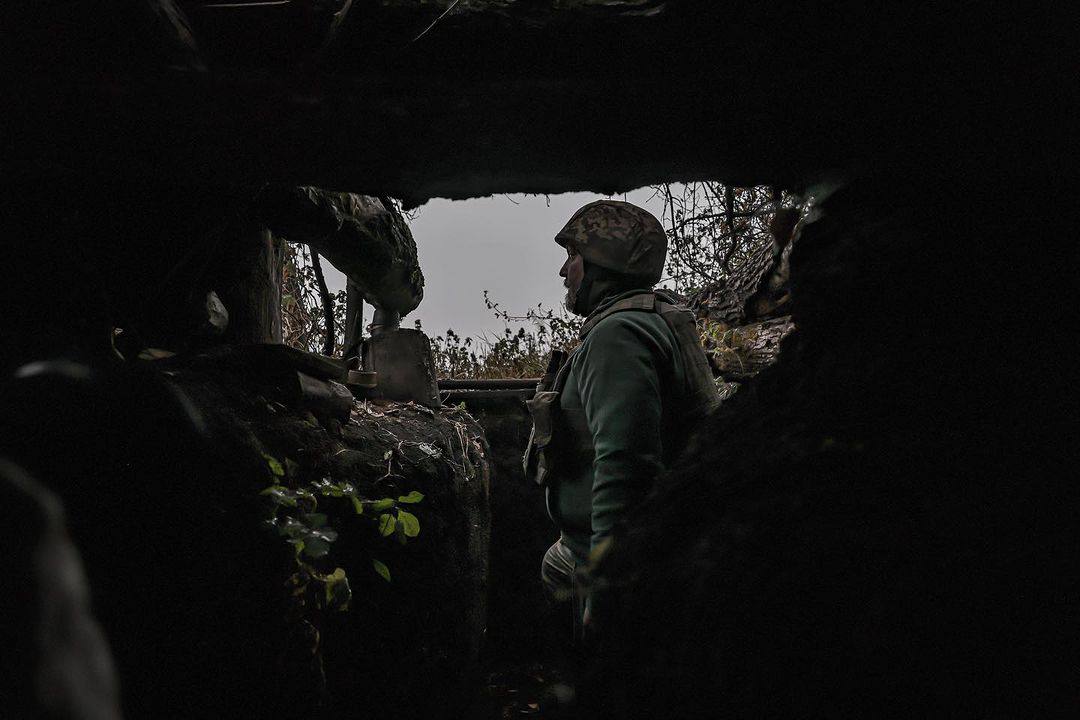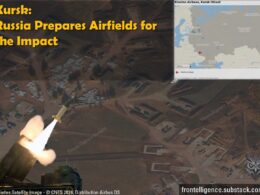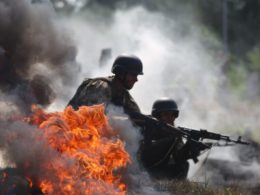The Russian army continues its massive onslaught on Avdiivka in the Donetsk Oblast (eastern Ukraine), attempting to encircle the Ukrainian stronghold. Russian troops suffer heavy losses but fail to break through the Ukrainian defense and cut off key supply routes to the Avdiivka garrison.
However, Russian pressure on the eastern front forced the Ukrainian military command to redeploy troops from the Zaporizhzhia Oblast (southeastern Ukraine) to reinforce the Avdiivka sector. Thus, despite minor territorial gains, the Avdiivka offensive helped Russia divert Ukrainian forces away from the southern front, where Ukraine’s grinding counteroffensive is still underway.
While Russia is stepping up its attacks on the eastern front to seize the strategic initiative, the Ukrainians continued to expand their bridgehead on the eastern bank of the Dnipro River in the Russian-occupied part of the Kherson Oblast (southern Ukraine), about 90 kilometers from Crimea. According to Russian military bloggers, Ukraine’s Armed Forces have started to move armored vehicles across the Dnipro River.
Meanwhile, Ukraine’s Armed Forces used homemade kamikaze drones and Western-supplied Storm Shadow/SCALP-EG and ATACMS missiles to pound military targets in Russian rear areas. Ukrainian strikes have inflicted significant damage on the Russian Black Sea Fleet and air defense systems in occupied Crimea (southern Ukraine).
Avdiivka meat grinder
Russia launched its onslaught on Avdiivka on 9 October 2023. After almost a month of heavy fighting, Russian troops managed to advance a little on the flanks north and south of Avdiivka. However, this advance came at a great cost and did not solve any of the tasks set by the Russian command.
Tactically, capturing Avdiivka allows Russia to control vital roads and the railway to Donetsk, which has been occupied by Russia since 2014. Avdiivka is less than ten kilometers north of Donetsk, a key Russian logistics hub in eastern Ukraine. Control over Avdiivka allows Ukraine’s Armed Forces to strike at all Russian ground lines of communication around Donetsk.
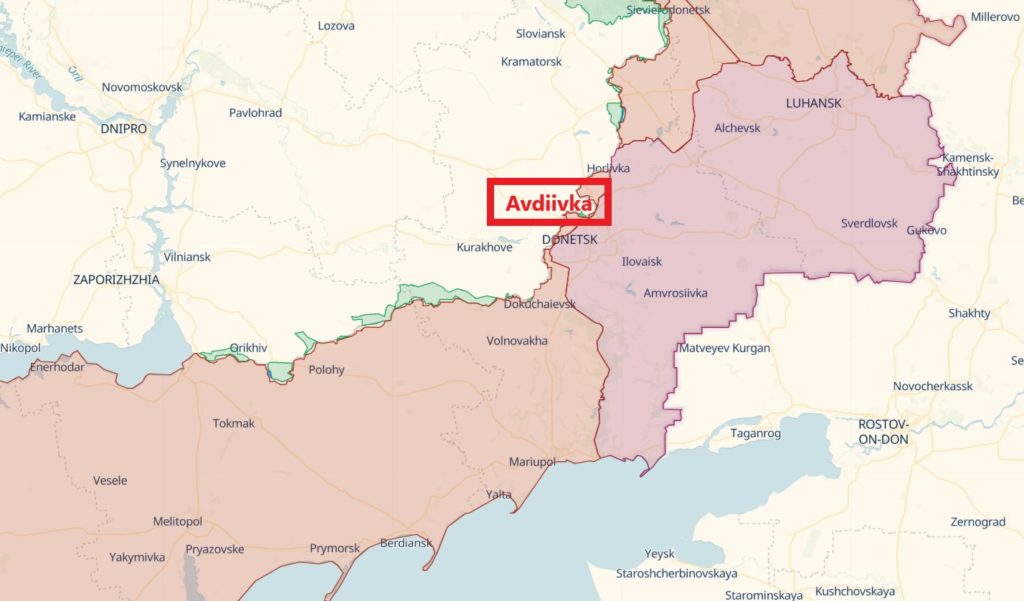
Map by Deep State.
The Russian plan to encircle and occupy Avdiivka in a stunning blitzkrieg of mechanized brigades supported by aviation and artillery has failed. The Russians did not cut off the Ukrainian key supply route (highway 0542) west of Avdiivka and failed to occupy the Avdiivka Coke and Chemical Plant, which is a gateway to the city from the northeast. Without the capture of the coke plant, the stability of the Avdiivka's defenses can hardly be disrupted. This heavily fortified area remains under complete Ukrainian control.
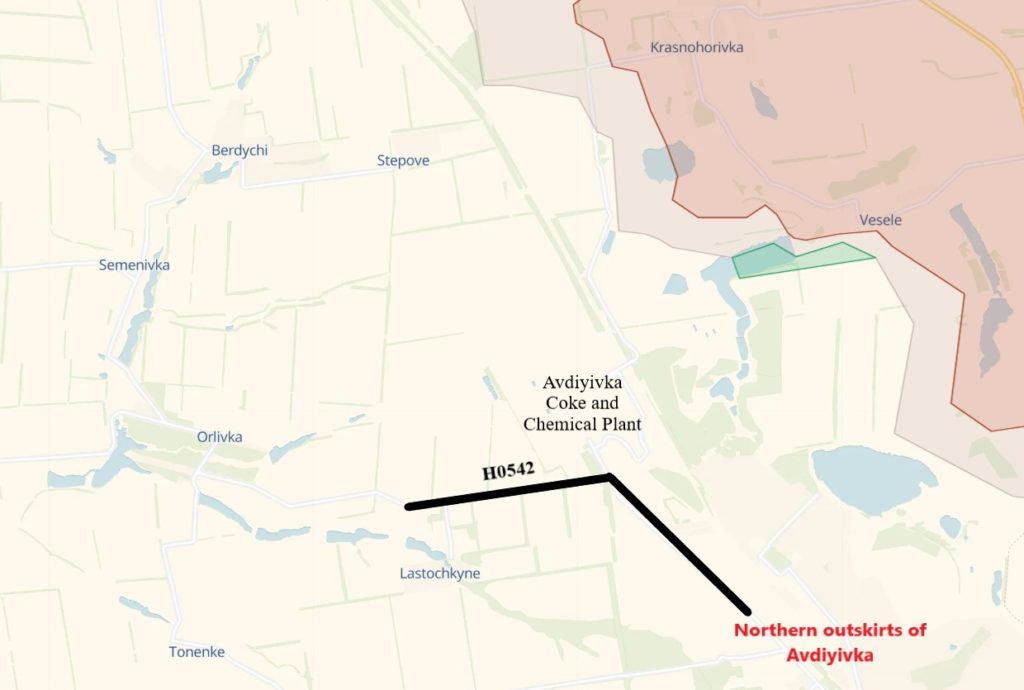
Map by Deep State.
Although Russian forces have managed to dislodge Ukrainian defenders from a forty-meter-high slag heap (Avdiivka Terrikon) east of the Avdiivka coke plant, Ukrainian artillery fire (including shelling with cluster munitions) and kamikaze drone attacks are preventing the Russians from gaining a foothold and concentrating forces on this strategically important height.
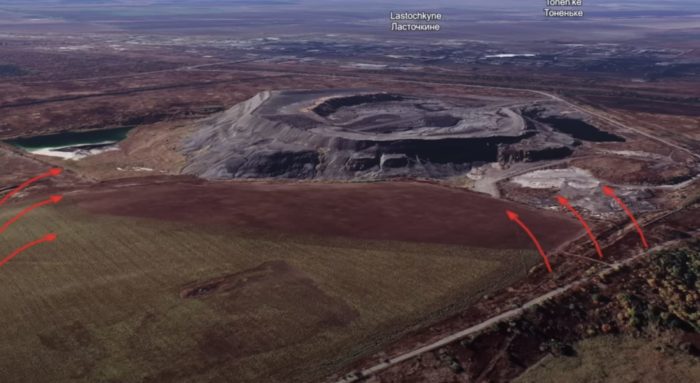
According to the spokesman for the Tavria operational group of forces of the Ukrainian Army, Oleksandr Stupun, Russia has deployed up to 40,000 troops to the Avdiivka sector.
Ukraine also reinforced the Avdiivka garrison, having redeployed the 47th Separate Mechanized Brigade from the Zaporizhzhia direction. This brigade, equipped with US-made Bradley infantry fighting vehicles and German-made Leopard main battle tanks, had previously taken part in the Ukrainian counteroffensive on the southern front, mainly near Robotyne in the Zaporizhzhia Oblast.
Both sides have enough reserves to continue the battle of Avdiivka for a long time. Despite heavy casualties, there are no signs that the Russian leadership is ready to abandon its attempts to encircle the Ukrainian stronghold and redirect its efforts to other, more strategically significant parts of the front.
According to an independent OSINT monitoring group, GeoConfirmed, Russia suffered the greatest losses northeast and southwest of Avdiivka.
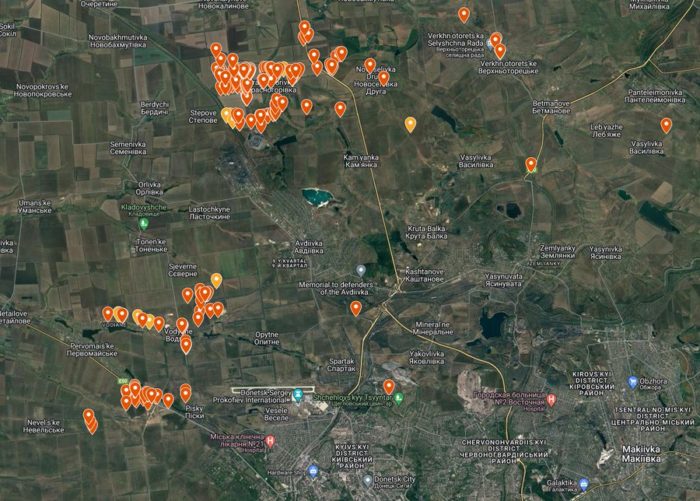
Credit: GeoConfirmed.
These are the areas of the biggest concentration of Russian forces and the main directions of the Russian offensive on the flanks of Avdiivka, designed to encircle the city. The Russian army managed to advance slightly on the northern flank, from occupied Krasnohorivka to Ukrainian-controlled Stepove. The frontline northeast of Avdiivka now runs along the railroad tracks.
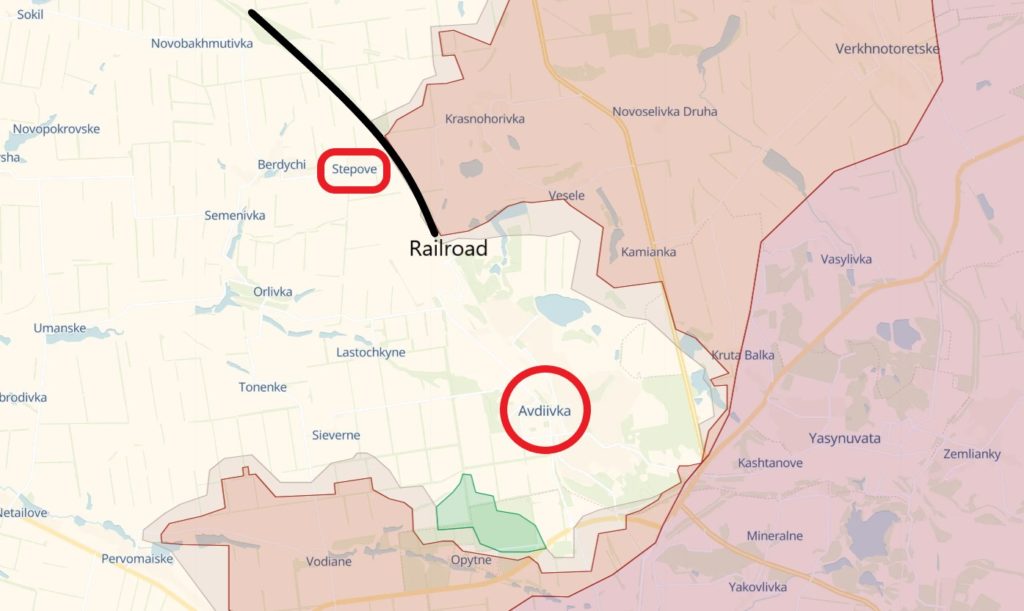
Map by Deep State.
Although Russian troops have already crossed the railroad tracks in some places, Ukrainian artillery is preventing them from gaining a foothold. According to Yurii Butusov, a Ukrainian war reporter, Russian troops are slowly but steadily advancing north of Avdiivka through a narrow corridor in the lowlands up to 4 kilometers wide.
“From this corridor, they [the Russians – ed.] are trying to cut Ukrainian supply lines to Avdiivka, which are 8 kilometers wide. Most of the enemy's rotations and reserves are defeated while still moving forward, as Ukrainian troops securely hold the flanks and control the dominant heights with convenient sectors of fire. The Russian infantry suffers significant losses, and it is much harder for the enemy to advance and hold their positions than for us to defend. The situation near Avdiivka poses much more risks for Russian troops than for us. The Ukrainian 110th Mechanized Brigade is demonstrating exceptional combat capability and reliably holding the city, preventing the enemy from getting a foothold in the urban area.” Yurii Butusov wrote on Telegram.
Southwest of Avdiivka, Ukrainian troops have halted the Russian advance near Sievierne and Opytne. The Russians continued their attempts to expand the foothold in the area of the sand quarry near the village of Opytne. However, the Ukrainians have much more favorable positions in terms of tactics, holding the flanks of the Russian breakthrough well, according to Yurii Butusov.
After the failure of the first two waves of the massive onslaught on the northern and southern flanks of the Avdiivka sector, the Russian army adjusted its offensive tactics. During the first stages of the offensive in mid-October, Russian forces attacked fortified Ukrainian positions with columns of tanks and armored vehicles.
https://twitter.com/EuromaidanPress/status/1718878399031128115
The assaults of Russian mechanized brigades were accompanied by air strikes and relentless artillery fire (the Avdiivka offensive coincided with reports that North Korea had supplied Russia with one million artillery shells).
However, after Russia suffered heavy losses in military equipment due to mines, kamikaze drone attacks, and artillery strikes for several weeks, Russian military commanders stopped throwing columns of armored vehicles and tanks into Ukrainian minefields. Instead, Russia switched to infantry-led assaults (so-called “meat assaults”) combined with heavy artillery preparation.
https://twitter.com/EuromaidanPress/status/1720622139143815635
According to the spokesman for the Tavria operational group of forces of the Ukrainian Army, Oleksandr Stupun, since 10 October, Russia lost around 7,000 troops (killed in action and wounded in action) during the Avdiivka offensive.
Because Russians are poor at evacuating the wounded from the battlefield and providing them with emergency medical care, the number of Russian soldiers who died after being wounded can be extremely high. Russian military bloggers have openly admitted
this problem on social media.
According to the Institute for the Study of War (ISW), Russia actively uses Storm Z assault units made up of prisoner recruits “in highly attritional infantry-led frontal assaults” in the Avdiivka sector.
A Russian instructor with a call sign Philologist reportedly serving in the Donetsk Oblast (eastern Ukraine) mentioned irreversible losses of Storm Z units in Avdiivka amount to 40-70%. He also stated that Storm Z units are often sent to the battlefield without reconnaissance or coordination with neighboring units.
“Storm Z assault infantry in the Avdiivka sector and the southern flank of Bakhmut are literally wiped out almost to zero in a few days of active operations. The critical problem is the lack of proper artillery support for attacks and counterattacks, which in fact turn into the notorious meat assaults,” the Philologist wrote on Telegram.
Another Russian military blogger claimed that Russian “meat assaults” without significant artillery and armored vehicle support failed to produce results.
“Right now, the situation in the Avdiivka sector is such that we cannot get into small arms combat range. We are being reeled in from mortars and automatic grenade launchers on the approach. Our tanks start working, enemy kamikaze drones immediately seek them out. The infantry has no support and suffers heavy losses. This is the "meat assault" in its purest form. The result is zero,” he wrote on Telegram.
Although the Russian offensive is bogged down in stiff Ukrainian resistance, the battle of Avdiivka has already diverted Ukrainian forces from other important sectors of the frontline, allowing Russia to come back into the fight for strategic initiative. On the other hand, the Avdiivka offensive has become the costliest for the Russian army since the beginning of the full-scale invasion of Ukraine. The loss ratio is not in Russia’s favor.
Russian losses
According to the data published by the General Staff of Ukraine’s Armed Forces, in October, Russia lost 521 tanks (while the average rate of losses is about 249 Russian tanks per month), 843 infantry fighting vehicles (the average rate of losses is about 468 fighting vehicles per month), 773 artillery systems (the average rate of losses is about 345 artillery systems per month), and 22,920 troops killed in action (the average monthly rate of Russian losses is about 14357 troops).
Since the beginning of its full-scale invasion of Ukraine, Russia has never lost more tanks during one month of fighting. According to Ukraine’s General Staff, last week alone, the Russian army lost 98 tanks (the average weekly rate of losses is about 59 tanks).
https://twitter.com/EuromaidanPress/status/1718000702231069106
In September 2023, the Institute Action Resilience (IAR), the French research institution, published a report on the armored potential of the Russian army. According to the IAR’s estimates, as of February 2022, the Russian army had 7,000 tanks of all types in storage bases, with Soviet-era T-72 main battle tanks (of all modifications) predominating.
It is unclear how many of the 7,000 tanks (of all modifications) Russia had before its full-scale invasion of Ukraine can drive and fire and how many will be dismantled for spare parts. It is also hard to say exactly how many of these tanks have already been destroyed in Ukraine.
According to Oryx, since the beginning of its all-out war against Ukraine, Russia has lost at least 2475 (of which 1618 tanks were destroyed, 140 were damaged, 167 were abandoned, and 550 were captured by Ukraine’s Armed Forces). Needless to say, a substantial amount of tank losses remain undocumented by OSINT analysts (due to the high intensity of combat, not all losses can be confirmed visually at this time). According to Ukraine’s General Staff, Russia has already lost 5,293 tanks in Ukraine (as of 7 November 2023).
Estimated Russian losses on day 622 of Russia's invasion of Ukraine, according to the Ukrainian army's General Staff. pic.twitter.com/ALkbEjfnfE
— Euromaidan Press (@EuromaidanPress) November 7, 2023
Although Russia is ramping up the production of main battle tanks, it still lags behind the heavy losses the Russian army sustains on the battlefield in Ukraine. According to the Director of the Ukrainian Center for Army, Conversion and Disarmament Studies, Valentyn Badrak, Russia can produce about 150 new tanks a year.
At this rate of losses (based on the data provided by Oryx) and tank production, Russia will have around 2,000 tanks left in 20 months, a significant part of which may be cannibalized for spare parts. Poorly planned onslaughts like the Avdiivka offensive only accelerate the depletion of Russia's tank potential.
According to Naalsio, an OSINT analyst who documents Ukrainian and Russian military equipment losses based on photo and videographic evidence, from 9 October to 3 November, Russia lost 209 units of military equipment in the Avdiivka sector.
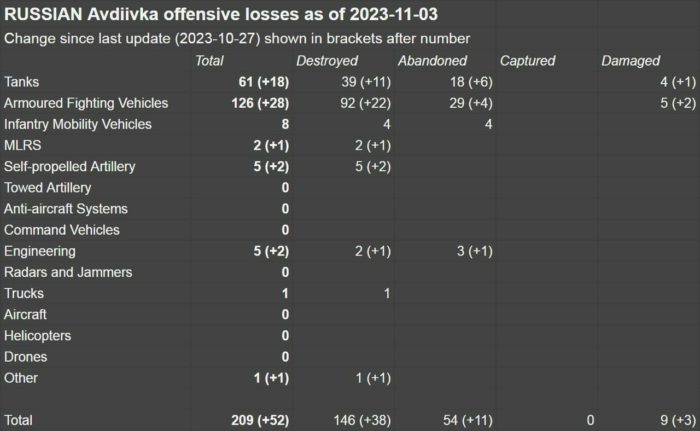
Credit: Naalsio.
Ukraine lost 14 units of equipment while defending Avdiivka.
Trending Now
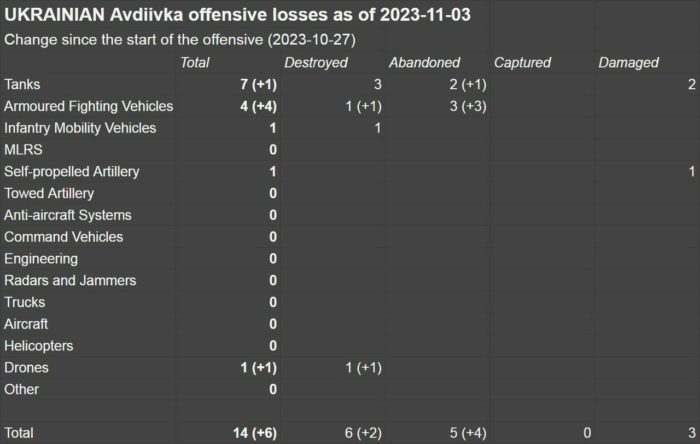
Credit: Naalsio.
Southern front
On the southern front, Ukrainian forces continued attempts to expand their zone of control on the flanks of Robotyne in the Zaporizhzhia Oblast. According to the ISW, the Ukrainian Army advanced west of Russian-controlled Verbove and east of occupied Kopani.
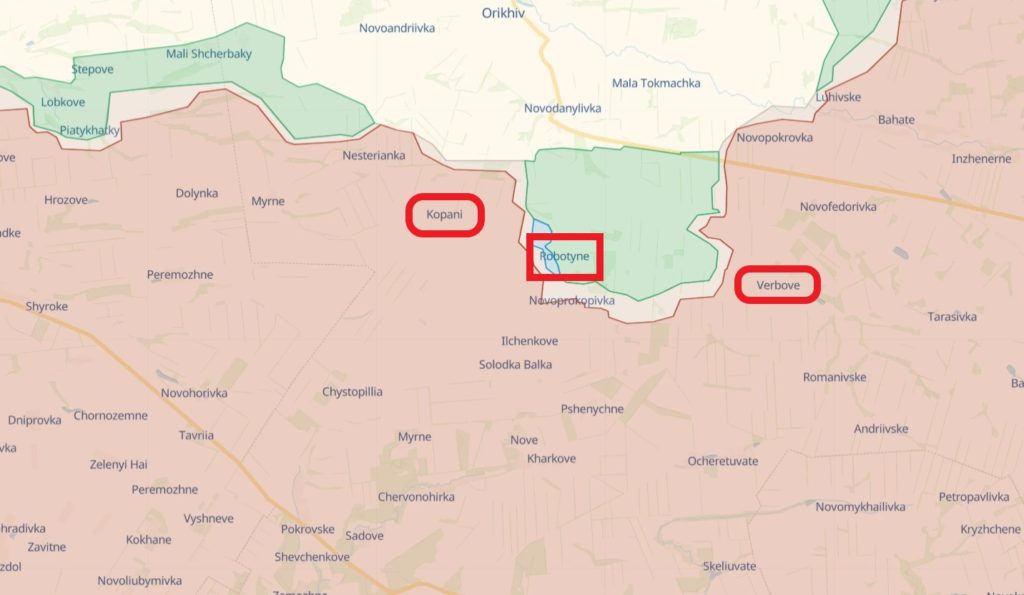
Map by Deep State.
Although the Commander-in-Chief of Ukraine's Armed Forces told the Economist last week that the Ukrainian counteroffensive has not yielded the results he had hoped for, the culmination of the offensive is still far from over. While the fight against the invading Russian forces is deadlocked in the Zaporizhzhia Oblast (southeastern Ukraine), recent developments in the Kherson Oblast (southern Ukraine) suggest that a possible breakthrough for Ukrainian forces could yet occur in another unexpected area of the southern front.
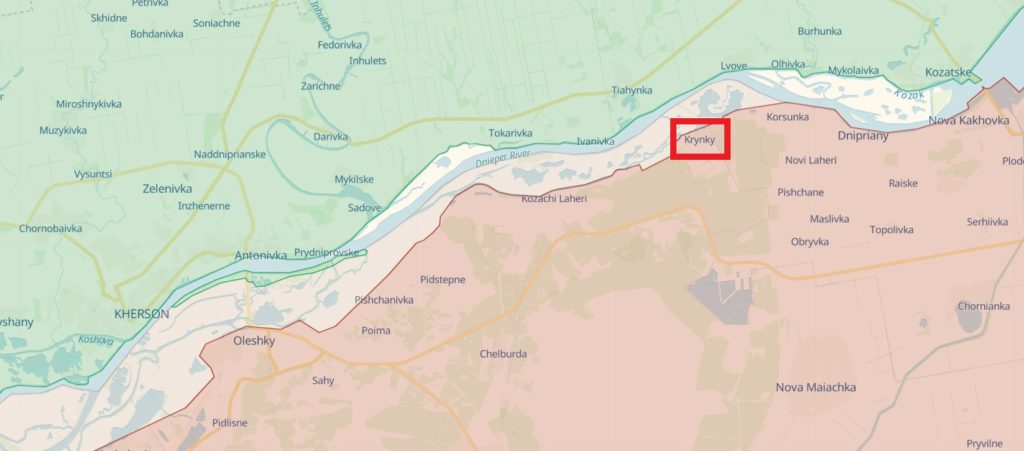
Map by Deep State.
On 14 October, the Ukrainian Armed Forces established a bridgehead in Krynky on the eastern bank of the Dnipro River in the Russian-occupied part of the Kherson Oblast. Unlike previous raids by Ukrainian troops across the Dnipro River, the situation in and around Krynky is different.
The Russian military command expected that the Dnipro River would be a reliable natural obstacle that Ukrainian troops would not be able to ford. Russia moved its most capable units to other sectors of the front. There are no vast Russian minefields and fortifications on the eastern bank of the Kherson Oblast.
Unlike other regions of Ukraine, where the rainy season obstructs military maneuvers by turning the terrain into a muddy swamp, the area in the Kherson Oblast south of Krynky has sandy soil. The mud season that began in November would not turn the ground on the eastern bank of the Kherson Oblast to viscous sludge.
On 5 November, Russian military bloggers reported that a Ukrainian BTR-4E infantry fighting vehicle crossed the Dnipro River to join the foothold established by Ukrainian troops in Krynky.
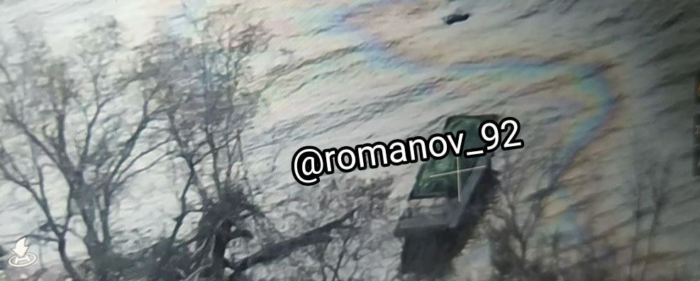
Credit: Romanov Light via Telegram.
This is the first sighting of Ukrainian heavy vehicles on the Russian-controlled bank of the Dnipro River in the Kherson Oblast since the beginning of the full-scale invasion of Ukraine. The situation in this area seems to be spinning out of Russian control. It is 84 kilometers of flat fields from Krynky to occupied Crimea, with no rivers or hills that the Russian Army can use as natural obstacles.
The Russian military command is pulling up reserves in this area and has changed the commander of the Dnipro Grouping of Russia's Armed Forces responsible for the Kherson Oblast due to the loss of positions.
https://twitter.com/EuromaidanPress/status/1719920264635683213
The deputy commander of Russian forces in Ukraine, Colonel General Mikhail Teplinsky, took over Russia’s Dnipro Grouping and replaced Colonel General Oleg Makaevich, who previously held the post.
Shortly after Mikhail Teplinsky was appointed, on 1 November, the Ukrainian Army conducted a missile strike on the headquarters of the Russian Dnipro Grouping of Forces in the Kherson Oblast.
One of the Russian military bloggers stated
that Ukrainian forces launched Storm Shadow cruise missiles and Neptune anti-ship missiles targeting Strilkove in the Kherson Oblast. He added that Russian air defenses only intercepted half of the incoming missiles. Russian losses after the Ukrainian missile strike are yet to be clarified.
Over the past week, the Ukrainians continued to widen the bridgehead near Krynky, slowly moving south toward a strategically important T2206 highway that connects Crimea with occupied Melitopol, a vital logistics hub in the Zaporizhzhia Oblast. Cutting this highway off would significantly disrupt Russian logistics in southern Ukraine.
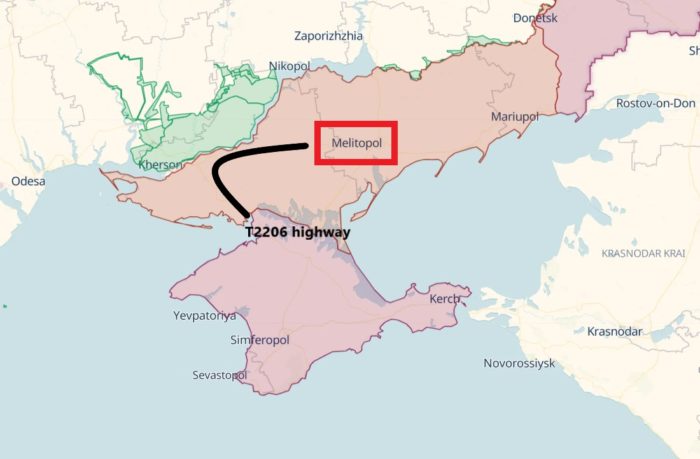
Map by Deep State.
Effective counterbattery artillery fire and extensive use of FPV kamikaze drones do not allow Russian troops to approach Krynky and push the Ukrainians out of the town.
https://twitter.com/EuromaidanPress/status/1721694016687784298
Ukrainian electronic warfare systems limit Russia's ability to use kamikaze and reconnaissance drones in the area. The situation may worsen for the Russians if Ukraine manages to reinforce the bridgehead in Krynky with full-fledged mechanized brigades.
Ukraine squeezes Russia’s Black Sea Fleet out of Crimea
On 4 November, Ukraine launched a series of missile strikes on a shipyard in Kerch (occupied Crimea, southern Ukraine).
According to Strategic Communications Center of Ukraine's Armed Forces, the strikes were aimed at the maritime and port infrastructure of the Zaliv shipyard in Kerch, a city in immediate proximity to the Crimea bridge connecting the occupied Ukrainian peninsula to southwestern Russia.
Russia’s Ministry of Defense confirmed the strike on the shipyard, claiming that the Russian air defense managed to take down 13 of 15 Ukrainian cruise missiles.
The missile strikes damaged a modern Askold warship drydocked in the Kerch shipyard. Askold, a Russian Kalibr cruise missile carrier, was undergoing final test work before joining Russia's all-out war against Ukraine.
Ukrainian Army's StratCom Dept confirmed that the Russian Navy's Askold small missile carrier sustained damage during Ukraine's Nov 4 missile attack on a shipyard in Russian-occupied Crimea.
Read more: https://t.co/N8jloVPyNG https://t.co/ooqpqpry5M
— Euromaidan Press (@EuromaidanPress) November 7, 2023
Ukraine’s Air Force commander, Mykola Oleshchuk, confirmed that French SCALP missiles were used for the strike.
Since the beginning of the full-scale Russian invasion of Ukraine in February 2022, Ukraine's Armed Forces have destroyed seven and damaged 16 warships of Russia's Black Sea Fleet. Ukrainian missile strikes and maritime kamikaze drone attacks forced Russia to relocate some of its Black Sea Fleet vessels.
The satellite imagery from Planet Labs revealed that the number of Russian ships has decreased in Crimea and that the core of the Russian Black Sea Fleet is no longer stationed in Sevastopol (southern part of the Crimean Peninsula).
Russia relocated at least three submarines, two missile launching ships, and one patrol ship from occupied Crimea to Novorossiysk in southwestern Russia. Smaller ships, including an assault landing ship, missile carriers, and mine sweepers, were relocated to Feodosiya (the eastern part of Crimea, closer to mainland Russia).
Thus, within the last year, the world’s second-largest navy has been forced to relocate a significant portion of its missile carriers from occupied Crimea to the northeastern part of the Black Sea, more than 570 kilometers away from Odesa (southwestern Ukraine) and other top-priority targets west of the Crimean Peninsula.
The tug of war
Within the last week, Ukrainian forces continued to advance south of Russian-occupied Bakhmut in the Donetsk Oblast (eastern Ukraine), the ISW reported.
Russian troops counterattacked on the northern flank of Bakhmut, trying to push Ukrainian forces out near Russian-controlled Berkhivka. The Ukrainian advance in this area may disrupt Russian logistics in the Bakhmut sector.
https://twitter.com/EuromaidanPress/status/1719549833474720004
At the same time, Russia attempted a massive assault on Vuhledar, a critical Ukrainian-controlled logistics hub in the Donetsk Oblast. Ukrainian troops repelled an attack by Russian armored vehicles and tanks near Mykilske, southeast of Vuhledar.
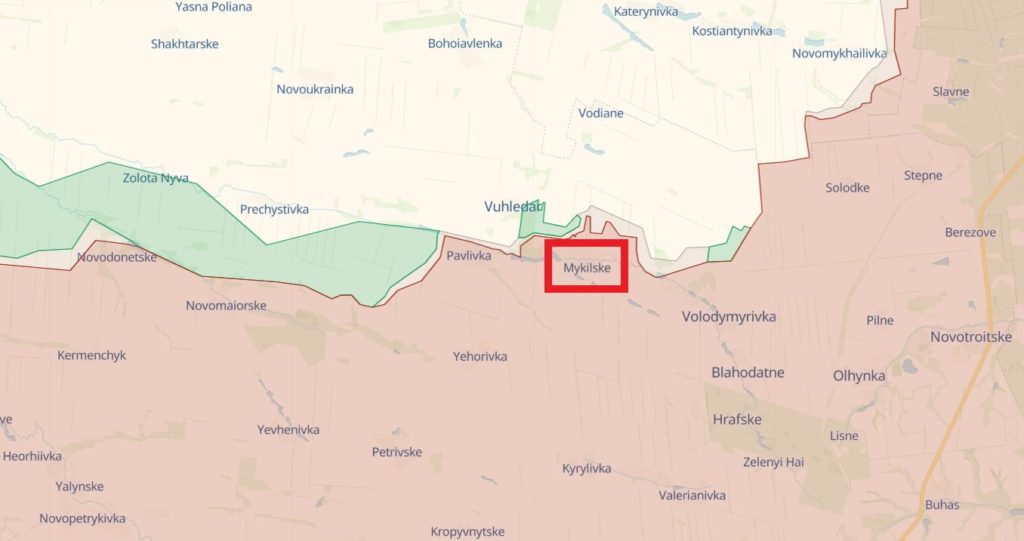
Map by Deep State.
On 2 November, Russian troops suffered heavy losses during the attack on Vuhledar and were forced to retreat. Russia has been trying to occupy Vuhledar for more than a year with no success.
https://twitter.com/EuromaidanPress/status/1720410496216470011
Within the last week, Ukrainian forces continued to conduct counteroffensive operations south of Russian-occupied Bakhmut in the Donetsk Oblast (eastern Ukraine), the ISW reported. However, neither Ukrainian nor Russian attacks around Bakhmut have been successful over the past week.
The last month has been marked by Russia's attempts to regain strategic initiative along the entire front line, stretching more than 1,200 kilometers. Whether Russia will be able to turn the tide of the war depends on many factors, including Russia's ability to ramp up the production of artillery shells and military equipment, Western military support for Ukraine, and the Ukrainian will to fight for its freedom and independence.
During almost two years of full-scale war, Ukraine has not allowed its ability to resist Russian aggression to be questioned.
Related:
- Top Ukrainian general says Ukraine already hit occupied Crimea with ATACMS missiles
- How Ukraine's scrappy marine drones are revolutionizing naval warfare
- Russia runs out of tanks as war intensifies
- Ukraine’s Commander-in-Chief reveals his strategy to defeat Russia
- Zelenskyy announces change in strategy after the article by Ukraine's top general Zaluzhnyi, where he described key challenges
- Military analysis: Mud season could aid Ukraine's offensive on southern front

